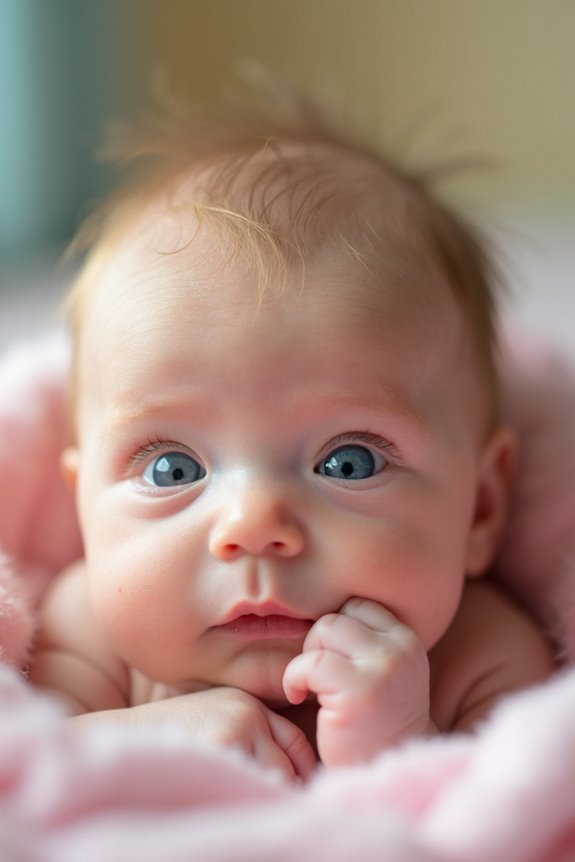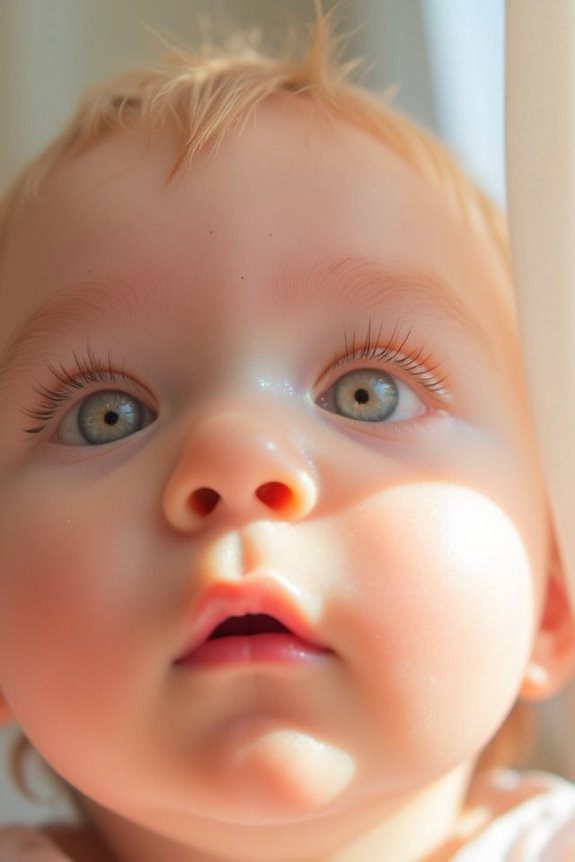Not all babies are born with blue eyes! In fact, only about 20.8% of newborns have blue eyes at birth. Most infants, around 63%, are born with brown eyes, and about 5.7% have green or hazel eyes. Eye color can change dramatically in the first year as melanin levels increase. These shifts depend on genetics and ethnicity, reflecting our diverse heritage. If you’re curious about the factors influencing eye color, keep exploring this fascinating topic!
Key Takeaways
- Only about 20.8% of newborns have blue eyes at birth; the majority have brown eyes.
- Approximately 63% of newborns are born with brown eyes, particularly in Asian and African ethnicities.
- Many Caucasian newborns start with blue eyes, which may change as melanin develops.
- Eye color can shift significantly within the first year due to melanin production and genetic factors.
- Most babies have little melanin at birth, often resulting in blue or gray eyes initially.
The Reality of Newborn Eye Colors
When it comes to newborn eye colors, it’s fascinating to learn that not all babies are born with blue eyes—only about 20.8% actually have this hue at birth. In fact, many of us might be surprised by the reality. Here’s a quick breakdown of newborn eye colors:
- Brown Eyes: Approximately 63% of newborns are born with this rich color.
- Green/Hazel Eyes: Around 5.7% exhibit these captivating shades.
- Indeterminate: Nearly 10% have colors that remain uncertain initially.
Common misconceptions lead us to believe that blue is the default. However, eye color can shift significantly within the first year due to melanin production. Understanding these facts helps clarify the beautiful diversity in newborn eye colors we get to cherish.
Ethnic Variations in Eye Color
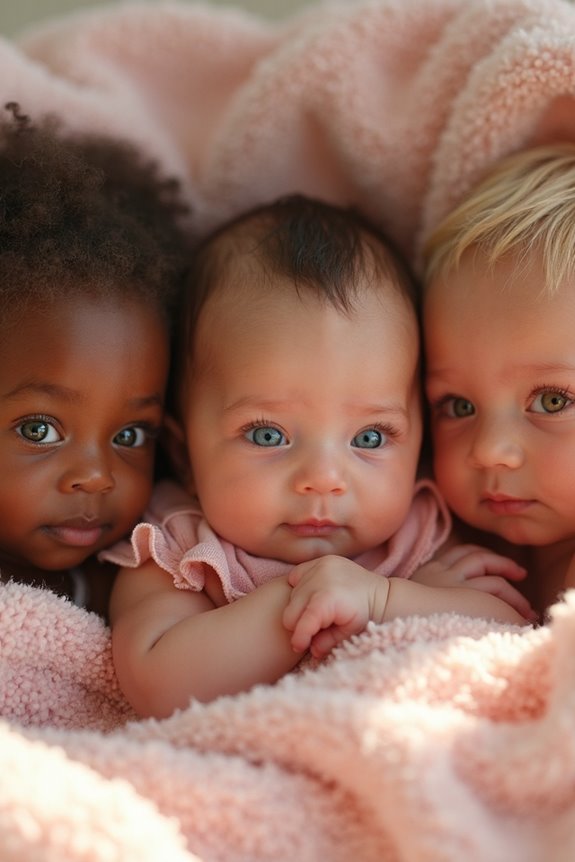
While we often think of eye color as a simple trait, it’s influenced by a variety of factors, particularly ethnicity. Understanding eye color prevalence among different ethnic groups can shed light on why certain colors are more common.
- Brown Eyes: Predominantly found in Asian, Pacific Islander, and African infants.
- Blue Eyes: More common in Caucasian newborns, especially those of European descent.
- Green/Hazel Eyes: Less frequent across all ethnicities.
These ethnic differences highlight the genetic complexity behind eye color. For instance, many Caucasian newborns start with blue eyes, while others typically have dark brown or black eyes. Recognizing these variations deepens our appreciation for the diversity of human characteristics and the beautiful spectrum of eye colors.
The Genetics Behind Eye Color
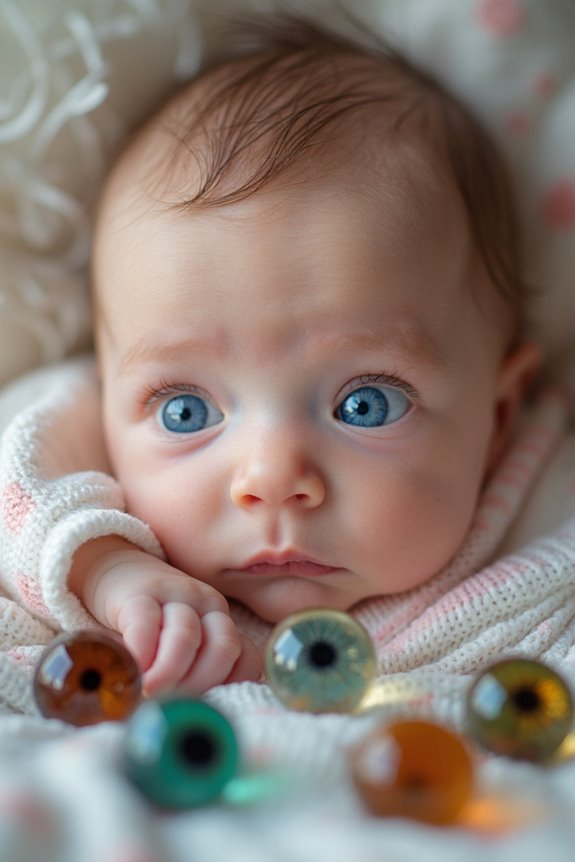
Understanding the genetics behind eye color helps us appreciate the fascinating complexity of this trait. Eye color inheritance isn’t as simple as we might think; it involves multiple genetic factors. Here’s a brief overview:
- Multiple Genes: At least eight genes, including the critical OCA2 gene, influence eye color.
- Dominant and Recessive: Some genes are dominant, while others are recessive, creating a mix in offspring.
- Melanin’s Role: The amount of melanin in the iris determines whether our eyes are blue, brown, or somewhere in between.
As we explore eye color, it becomes evident that predicting a child’s eye color is complex. Parental eye colors contribute, but the final outcome is a beautiful blend of genetic influences, reflecting our unique heritage.
Changes in Eye Color Over Time
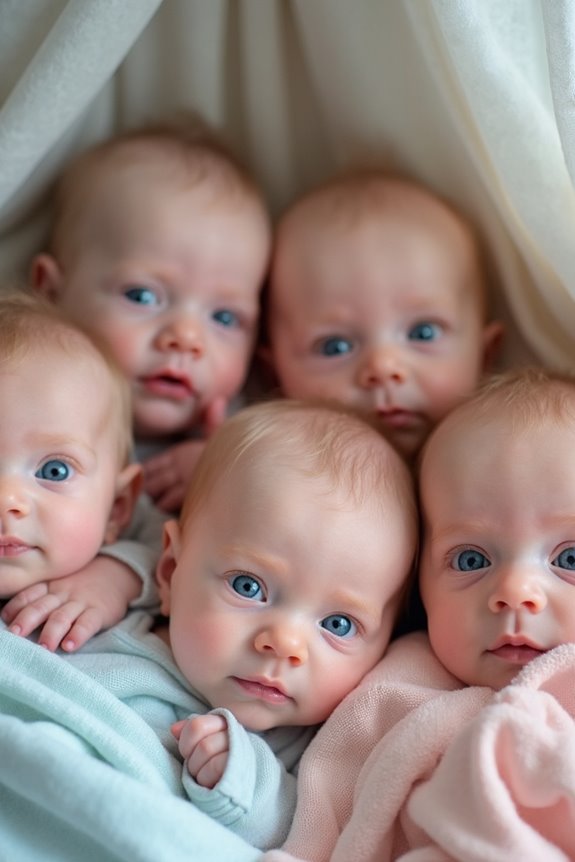
As we watch our little ones grow, it’s fascinating to realize that their eye color can change significantly during their early months. This eye color evolution is largely due to melanin accumulation.
- At birth, most babies have little melanin, giving them blue or gray eyes.
- As they develop, melanocytes become active, causing eye colors to shift to green, hazel, or brown.
- Significant changes typically happen between 3 and 6 months.
- By around 9 months, many children have their permanent eye color, but some may continue to change until their first birthday.
Understanding this process can help us appreciate the beauty of our babies’ unique journeys. Every child is different, and their eye colors reflect that individuality as melanin levels adjust over time.
Global Perspectives on Eye Color Prevalence

Eye color isn’t just a fascinating aspect of our little ones’ appearance; it also varies significantly across the globe. When we look at eye color prevalence, we see a rich tapestry shaped by cultural perceptions and historical beliefs.
- Brown Eyes: Most common worldwide, especially in Asia, Africa, and the Americas.
- Blue Eyes: More prevalent in Europe, particularly in Scandinavian and Baltic regions.
- Green and Hazel Eyes: These shades are rarer, with green often found in Ireland and Scotland.
Understanding these global differences helps us appreciate the beauty in diversity. It’s fascinating to think that our babies’ eye colors not only reflect genetics but also connect us to our cultural roots and histories. Isn’t that something special?
Insights From Recent Research and Studies

While many of us might think of eye color as a straightforward trait, recent research reveals a fascinating complexity behind what determines the hues of our babies’ eyes. It turns out that eye color is influenced by over 50 genes, making predictions tricky.
- Genetic Testing: Advances in genetic testing can help us estimate eye color, but these predictions aren’t foolproof due to the many alleles at play.
- Health Implications: Certain eye colors might hint at genetic predispositions to health issues, like glaucoma.
Understanding these nuances can empower us as parents. By examining family history and staying informed, we can care for our little ones’ eye health more effectively. Regular eye exams are essential for monitoring any changes!
Frequently Asked Questions
Do Parents’ Eye Colors Influence Their Baby’s Eye Color?
We know parents’ eye colors play a role in their baby’s eye color due to genetic inheritance. However, eye color genetics is complex, involving multiple genes that create beautiful variations beyond what we might expect.
Can Eye Color Predict a Child’s Personality Traits?
We’ve often wondered if eye color truly predicts personality traits. While many believe blue eyes mean sensitivity or brown eyes signify confidence, science shows no solid link. Let’s explore this colorful myth together, shall we?
Are Certain Eye Colors Associated With Specific Health Conditions?
When we explore eye color genetics, it’s fascinating to see how certain colors can serve as health indicators. Light eyes might increase risks for some conditions, reminding us of the unique connections between our appearance and well-being.
Can Exposure to Sunlight Change a Baby’s Eye Color?
Can sunlight really play a role in changing a baby’s eye color? We know it stimulates melanin production, influencing those beautiful hues over time. Isn’t it fascinating how nature combines light and genetics in such a way?
Is It Possible for a Baby to Have Multicolored Eyes?
Isn’t it fascinating how multicolored genetics can create such unique eye color variations? We’ve seen babies with rare conditions like heterochromia, showcasing the beautiful diversity in their little irises. It’s truly a wonder to behold!

